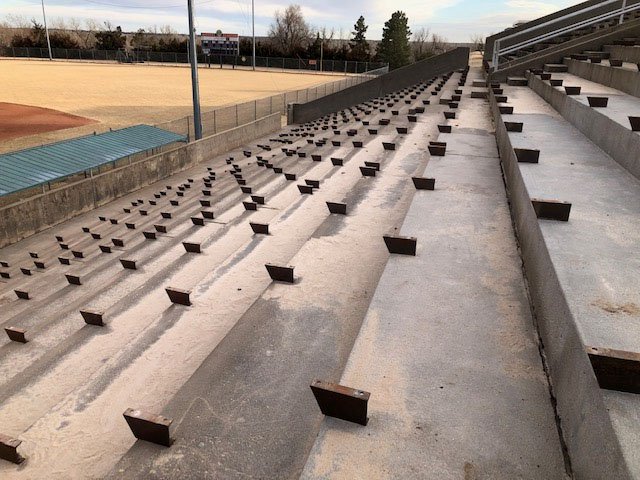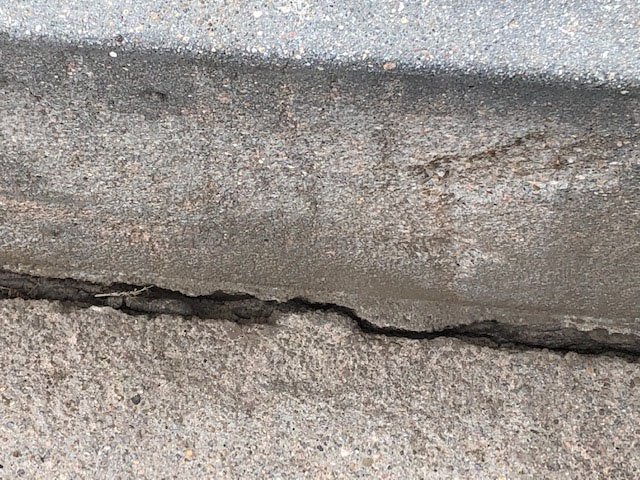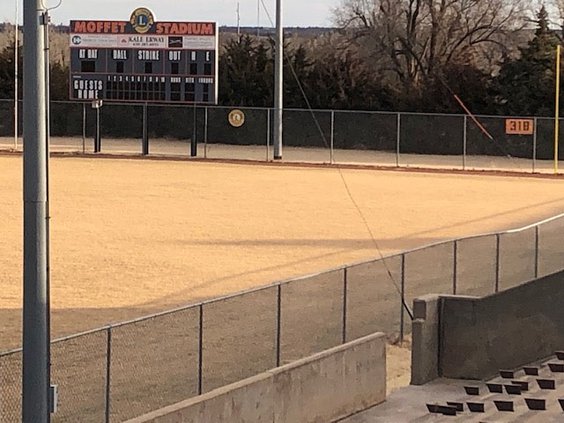LARNED — The Larned PRIDE organization has focused efforts on repairs and updates at Larned’s Moffet Stadium for several years now, but it recently came to the group’s attention more needs to be done, and fast, if the stadium is going to last. Angie Murray, a Larned PRIDE member, made a compelling case to city council members Monday night that resulted in swift action being taken.
Murray listed for the council the many projects the organization has partnered with the city to complete, an investment worth between $600,000 and $700,000 total. Many of the projects were made possible through Golden Belt Community Foundation grants. In 2017, a KDHE grant was secured to make updates to the furnishings of the stadium. In 2019, they took a deeper dive, and planned to update the south locker room in a similar fashion to the north locker room which has become a point of pride for varsity teams playing there.
“Our guests have nowhere to go when they’re changing,” Murray said. “They’re down there in the dugout and changing and our team is so large that there’s no room for the JV team in the north locker room.”
In recent weeks, group members began removing items the city had stored in the space for years and that’s when deterioration that has gone unchecked for years became apparent.
“There was a tremendous amount of damage that was pretty scary when you look at the integrity of the stadium itself,” she said.
Deteriorating cement and exposed and rusted metal and water infiltration were all present. The group called in Chad Eakins with Eakin Enterprises Inc., for his assessment. He brought in specialty vendors to talk about what the best fixes would be. Instead of fixing up the locker room, it was clear the remainder of the $4,500 for the project would need to be redirected into repairs, and that was not enough. Eakins was with Murray when she presented a detailed bid of $51,816 for the work needed in order to ensure the 70-year-old concrete structure does not deteriorate further. $47,316 would be the city’s share,


Scope of repairs needed
New expansion joints are needed along the entire East and West walls, and loose and delaminated concrete will need to be removed and the areas repaired with a rapid-setting concrete repair mortar. In order to complete the work, the aluminum bleachers will need to be removed and replaced. While they are off, workers will power wash the porous concrete surfaces beneath and sandblast where needed.
“There is no point in patching the bottom side of this without stopping the moisture migration through the concrete,” Eakins said.
To block moisture from soaking into the concrete, a specialty sealer, thinner than water, will be applied. All expansion joints in the concrete will need to be cleaned out and resealed with a polyurethane joint sealant.
“Those joints are like a funnel for moisture, taking it straight through,” Eakins said.
When concrete is new, it isn’t very porous. But the stadium was built over 80 years before as a Works Projects Administration project. Over time, through numerous freeze and thaw cycles, it has become more porous.
Repair is the less expensive option
Eakins estimates within 10 years or less, without the repairs the stadium may need to be condemned, and that could cost the city more than making the repairs now.
“This is a wild guess,” he said. “It could cost you $100,000 to tear it down and get it out of here, so we’re proposing half that to fix it, prolong the life of it to where we can continue to use it for years to come.”
Murray researched the history of the stadium in advance of the presentation. When it was proposed, it was estimated it would cost $11,000 to build in 1934. At any one time there were between 70 and 150 WPA workers involved in various projects around Larned, and the stadium was one of them. They carved the stadium’s bowl shape out of a hill, and in the process removed 20,000 yards of dirt. That’s equal to about 1,200 semi-loads.
The initial stadium build cost $11,000, but over the years the school and city has invested more into additions like the locker rooms and additional seating.
Author Mark Eberle’s book “Kansas Baseball, 1858-1941” includes photos and history of Moffet Stadium, Murray said. Buddy Tabler, Larned, also took a moment to say a few words about the stadium and Larned baseball.


No ADA conflict
For several years, the city has been under an order to update public facilities to comply with the Americans with Disabilities Act, with the deadline six years away. The immediate repairs needed are outside of these mandated orders, Murray said when city council members inquired.
“We want to make sure that this is not going to be something that would have to be redone later on,” City Manager Brad Eilts said.
Eakins said his crews are prepared to start work on the project right away. American Legion baseball and high school ball are expected to start the last week of March.
With a few more questions answered, the city council agreed to authorize spending up to $60,000 to move forward with repairs. The additional funds were authorized with the tight deadline in mind.





